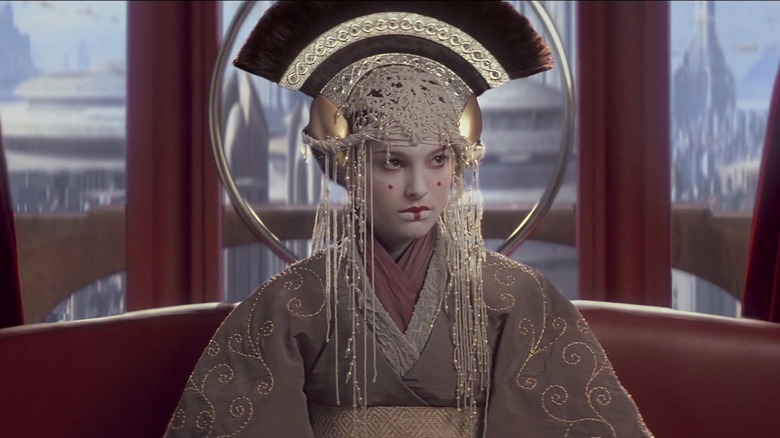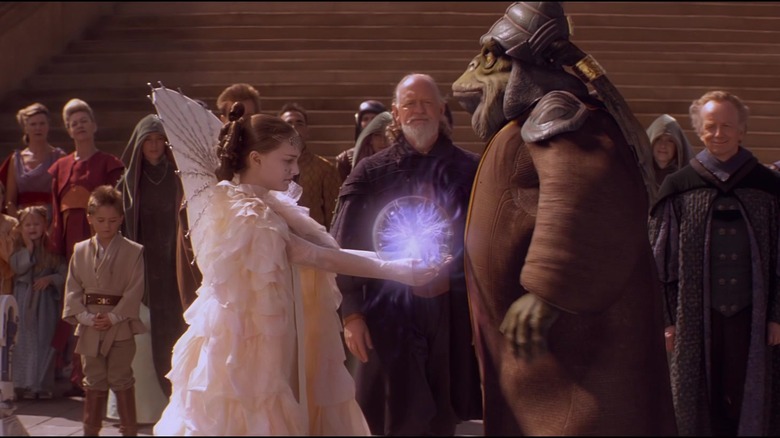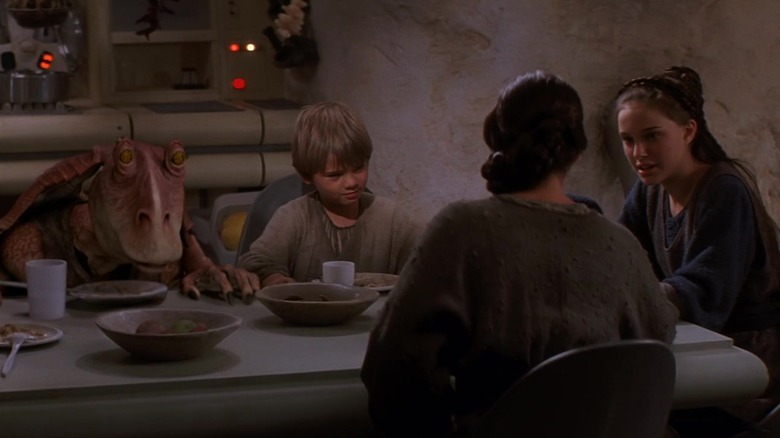Star Wars Was An Unfortunately Inevitable Career First For Natalie Portman
We take CGI for granted these days. It seems the only time we notice it is when something is wrong. If you get into acting in 2023, you know that there is a strong likelihood that you'll be working in front of a screen, imagining characters that aren't there and scenery that you can't really see. It's a very specific skill, trying to make people believe that you, too, can see what the audience is seeing. When "Star Wars: Episode I — The Phantom Menace" (1999) was filming, however, star Natalie Portman, who played Padmé Amidala, hadn't had much experience with it at all.
This amount of work in front of a blue screen added a lot of issues that she hadn't dealt with in the industry before. To be fair, "The Phantom Menace" had a lot more CGI than most films at the time. Whether you believe that was to the film's benefit or detriment is up to you, but as an actor, it added a new level of complexity for Portman, according to a 1999 interview with "Star Wars Insider" issue #44.
' ... there's a lot more for you to concentrate on than just acting and your lines'
Working against a screen with CGI characters wasn't something Portman had done outside of a small role in "Mars Attacks!," so her work in "The Phantom Menace" was a lot more complicated. There were a lot of characters that didn't exist. She was asked whether it was strange to be doing this blue screen work after so many "character-driven dramas." Portman said it was, and that it was largely new for her. She explained:
" ... it's weird because there's a lot more for you to concentrate on than just acting and your lines – like where you're looking and where your eye-line is. Sometimes you'll be looking at a blue screen, but you're supposed to be looking into someone's eyes, and it's kind of weird because your eyes focus differently when you're looking at a wall or if you're looking at a dot.
"But they can't put a dot on the screen for you, because it's a blue screen for a reason, you know? So you have everyone focusing at the same point and staying out of the way of a certain character if a certain character is there, but they're not really there. There's just more to think about."
Often productions will use techniques like having someone in a green (or blue) suit so the actor can focus their eyes correctly these days. You don't think a small thing like that will make a difference, but we instinctively know when someone is looking at us or someone else and focusing on them, versus letting their eyes drift or thinking about something else. It's obvious that something isn't right, even when we don't know why. That does come across on screen.
'It was a much harder job than I expected'
Though they did a great job for 1999, there are definitely moments where you can see the eyes of many of the actors not quite making contact with the CGI character's eyes or focusing correctly. (Again, it's 1999, and can be forgiven in a way that we might not forgive it now.) Portman had to work for this one, she said, and it wasn't what she was expecting. She revealed:
"It was a much harder job than I expected. I wasn't doing hard labor like some people were doing, but it was the first time I ever felt like it was a job. I expected it to be kind of easy because it's an action movie and I didn't have a lot of dramatic stuff to do in it. It's mainly a set-up movie, to set up the others. But it came out so cool! It looks so awesome. I can brag about the way it looks because it has nothing to do with me."
I'm not sure I agree with her use of "awesome" now, but despite not loving the film, I do remember being very impressed by the effects at the time. Having all these characters that didn't exist in real life was pretty cool. Whatever the level of CGI back then, a character like Jar Jar (Ahmed Best) led us to future CGI characters like Groot and Gollum. Hey, you have to start somewhere.
All the "Star Wars" films and TV series are currently streaming on Disney+.


